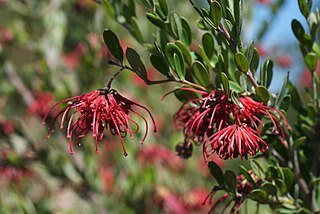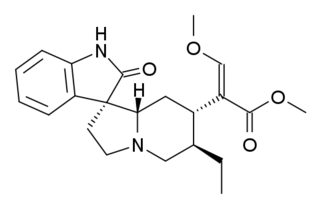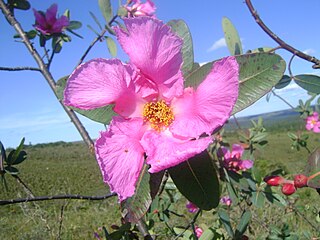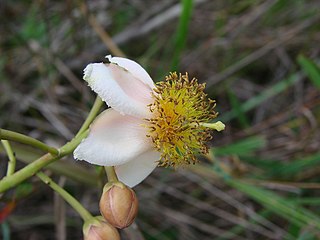
Chaenomeles is a genus of three species of deciduous spiny shrubs, usually 1–3 m tall, in the family Rosaceae. They are native to Southeast Asia. These plants are related to the quince and the Chinese quince, differing in the serrated leaves that lack fuzz, and in the flowers, borne in clusters, having deciduous sepals and styles that are connate at the base.

Mitragyna speciosa is a tropical evergreen tree in the coffee family native to Southeast Asia. It is indigenous to Thailand, Indonesia, Malaysia, Myanmar, and Papua New Guinea, where it has been used in herbal medicine since at least the nineteenth century. Kratom has opioid properties and some stimulant-like effects.

Gloxinia is a genus containing three species of tropical rhizomatous herbs in the flowering plant family Gesneriaceae. The species are primarily found in the Andes of South America, but Gloxinia perennis is also found in Central America and the West Indies, where it has probably escaped from cultivation.

The silk floss tree is a species of deciduous tree native to the tropical and subtropical forests of South America. It has several local common names, such as palo borracho, samu'ũ or paineira. In Bolivia, it is called toborochi, meaning "tree of refuge" or "sheltering tree". It belongs to the same family as the baobab and the kapok. Another tree of the same genus, Ceiba chodatii, is often referred to by the same common names.

Kielmeyera is a plant genus in the family Calophyllaceae. It is endemic to South America, with a large occurrence in the Brazilian cerrados.

Banksia speciosa, commonly known as the showy banksia, is a species of large shrub or small tree in the family Proteaceae. It is found on the south coast of Western Australia between Hopetoun (33°57′ S) and the Great Australian Bight, growing on white or grey sand in shrubland. Reaching up to 8 m (26 ft) in height, it is a single-stemmed plant that has thin leaves with prominent triangular "teeth" along each margin, which are 20–45 cm (7.9–17.7 in) long and 2–4 cm (0.8–1.6 in) wide. The prominent cream-yellow flower spikes known as inflorescences appear throughout the year. As they age they develop up to 20 follicles each that store seeds until opened by fire. Though widely occurring, the species is highly sensitive to dieback and large populations of plants have succumbed to the disease.

7-Hydroxymitragynine is a terpenoid indole alkaloid from the plant Mitragyna speciosa, commonly known as Kratom. It is often referred to as ‘7-OH’. It was first described in 1994 and is a natural product derived from the mitragynine present in the Kratom leaf. It is considered an oxidized derivative of mitragynine.

Grevillea speciosa, also known as red spider flower, is a shrub which is endemic to New South Wales in Australia.

Guettarda speciosa, with common names sea randa, or zebra wood, is a species of shrub in the family Rubiaceae found in coastal habitats in tropical areas around the Pacific Ocean, including the coastline of central and northern Queensland and Northern Territory in Australia, and Pacific Islands, including Micronesia, French Polynesia and Fiji, Malaysia and Indonesia, Maldives and the east coast of Africa. It reaches 6 m in height, has fragrant white flowers, and large green prominently-veined leaves. It grows in sand above the high tide mark.

Rhynchophylline is an alkaloid found in certain Uncaria species (Rubiaceae), notably Uncaria rhynchophylla and Uncaria tomentosa. It also occurs in the leaves of Mitragyna speciosa (kratom), a tree native to Thailand. Chemically, it is related to the alkaloid mitragynine.
Banksia splendida subsp. macrocarpa is a subspecies of Banksia splendida. It was known as Dryandra speciosa subsp. macrocarpa until 2007, when Austin Mast and Kevin Thiele sunk all Dryandra into Banksia. Since there was already a species named Banksia speciosa, Mast and Thiele had to choose a new specific epithet for D. speciosa and hence for this subspecies of it. As with other members of Banksia ser. Dryandra, it is endemic to the South West Botanical Province of Western Australia.
Banksia splendida subsp. splendida is a subspecies of Banksia splendida. It was known as Dryandra speciosa subsp. speciosa until 2007, when Austin Mast and Kevin Thiele sunk all Dryandra into Banksia. Since the name Banksia speciosa had already been used, Mast and Thiele had to choose a new specific epithet for D. speciosa and hence for this subspecies of it. As with other members of Banksia ser. Dryandra, it is endemic to the South West Botanical Province of Western Australia. As an autonym, it is defined as encompassing the type material of the species.

Ajmalicine, also known as δ-yohimbine or raubasine, is an antihypertensive drug used in the treatment of high blood pressure. It has been marketed under numerous brand names including Card-Lamuran, Circolene, Cristanyl, Duxil, Duxor, Hydroxysarpon, Iskedyl, Isosarpan, Isquebral, Lamuran, Melanex, Raunatin, Saltucin Co, Salvalion, and Sarpan. It is an alkaloid found naturally in various plants such as Rauvolfia spp., Catharanthus roseus, and Mitragyna speciosa.

Stigmella speciosa is a moth of the family Nepticulidae. It is found from Denmark to the Iberian Peninsula, Italy and Greece, and from Great Britain to the Ukraine.
Speciosa is an Irish-bred, British-trained Thoroughbred racehorse. In a racing career which lasted from June 2005 and October 2007 she ran seventeen times and won four races. As a two-year-old, she won two of her six races including an upset win in the Group Two Rockfel Stakes at Newmarket Racecourse. As a three-year-old she won the Nell Gwyn Stakes and then took the Classic 1000 Guineas for her trainer and part owner Pam Sly. She failed to win in nine subsequent races although she placed second in the Earl of Sefton Stakes and the Pretty Polly Stakes. She was retired at the end of the 2007 season to become a broodmare. Her front-running style and unconventional background made her a popular Classic winner.

Kielmeyera neglecta is a species of Kielmeyera from Brazil.

Kielmeyera rubriflora is a species of Kielmeyera from Bolivia to Brazil.

Kielmeyera neriifolia is a species of Kielmeyera from Brazil.

Protea speciosa, also known as the brown-beard sugarbush, is a flowering shrub which is classified as within the genus Protea.















